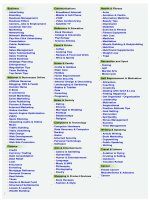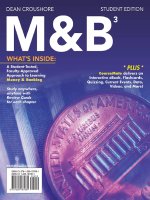Money and Banking: Lecture 4
Bạn đang xem bản rút gọn của tài liệu. Xem và tải ngay bản đầy đủ của tài liệu tại đây (509 KB, 33 trang )
Money and
Banking
Lecture 04
Review of the Previous Lecture
• Money
• Characteristics of Money
• Liquidity
• Payment system
• Commodity vs. Fiat Money
• Cheques
Topics under Discussion
• Payment system
• Other forms of payments
• Future of Money
• Measuring Money
• Definitions
• Monetary Aggregates
• Measures of Inflation
• Financial Instruments
Other Forms of Payments
•
•
•
•
Debit Cards
Credit Cards
Electronic Funds transfers
Stored Value Cards
Other Forms of Payments
• Debit Card
• The money in your account is used for
payments
• works like a cheque and there is usually a fee
for the transaction
Other Forms of Payments
• Credit card
• It is a promise by a bank to lend the
cardholder money with which to make
purchases.
• When the card is used to buy merchandise
the seller receives payment immediately
• The money that is used for payment does not
belong to the buyer
• Rather, the bank makes the payment, creating
a loan that the buyer must repay.
• So, they do not represent money; rather, they
represent access to someone else’s money
Other Forms of Payments
•
Electronic Funds Transfer
•
•
•
move funds directly from one account to
another.
Banks use these transfers to handle
transactions among themselves
Individuals may be familiar with such
transfers through direct deposit of their
paycheques and the payment of their utility
bills, etc
Other Forms of Payments
•
E-money
•
used for purchases on the Internet.
•
•
•
•
You open an account by transferring funds to the
issuer of the e-money
When shopping online, instruct the issuer to send
your e-money to the merchant
It is really a form of private money.
Stored-value card
•
Retail businesses are experimenting with
new forms of electronic payment
•
Prepaid cellular cards, Internet scratch cards,
calling cards etc..
The Future of Money
• The time is rapidly approaching when safe
and secure systems for payment will use
virtually no money at all
• We will also likely see
• fewer “varieties” of currency, (a sort of
standardization of money) and
• a dramatic reduction in the number of units of
account
• money as a store of value is clearly on the
way out as many financial instruments
have become highly liquid.
Measuring Money
Different Definitions of money based upon
degree of liquidity.
Federal Reserve System defines
monetary aggregates.
Measuring Money
• Changes in the amount of money in the
economy are related to changes in interest
rates, economic growth, and most
important, inflation.
• Inflation is a sustained rise in the general
price level
• With inflation you need more money to buy
the same basket of goods because it costs
more.
• Inflation makes money less valuable
• The primary cause of inflation is the issuance
of too much money
Measuring Money
• Because money growth is related to
inflation we need to be able to measure
how much money is circulating
• Money as a means of payments
• We measure the quantity of money as the quantity
of currency in circulation – an unrealistically limited
measure, since there are other ways of payments
Measuring Money
• Alternatively, broadly categorize financial
assets and sort them by the degree of
liquidity
• Sort them by the ease with which they can be
converted into a means of payments
• Arrange them from most liquid to least liquid
• Draw a line and include everything on one
side of the line in the measure of the money
• Where to draw the line?
Measuring Money
• In reality, we draw line at different places
and compute several measures of money
called the monetary aggregates
• M1, M2, and M3
Measuring Money
• M1 is the narrowest definition of money
and includes only currency and various
deposit accounts on which people can
write cheques.
•
•
•
•
Currency in the hands of the public,
traveler’s cheques,
demand deposits and
other chequeable deposits.
Measuring Money
• M2 includes everything that is in M1 plus assets
that cannot be used directly as a means of
payment and are difficult to turn into currency
quickly,
• small-denomination time deposits,
• money market deposit accounts,
• money market mutual fund shares.
• M2 is the most commonly quoted monetary
aggregate since its movements are most closely
related to interest rate and economic growth.
Measuring Money
• M3 adds to M2 other assets that are
important to large institutions
• large-denomination time deposits,
• institutional money market mutual fund
shares,
• repurchase agreements and
• Eurodollars.
Monetary Aggregates
_Symbol
C
Assets included
Currency
M1
C + demand deposits,
travelers’ cheques,
other chequeable deposits
M2
M1 + small time deposits,
savings deposits,
money market mutual funds,
money market deposit accounts
M3
M2 + large time deposits,
repurchase agreements,
institutional money market mutual fund
balances
Monetary Aggregates
Figures in millions as of March 2005
1. Currency issued
711,997
2. Currency held by SBP
3,188
3. Currency in tills of Scheduled Banks
43,914
4. Currency in circulation (1 – 2 – 3)
664,895
5. Scheduled Banks demand deposits
93,272
6. Other Deposits with SBP
4,826
7. M1 (4+5+6)
1,602,423
8. Scheduled Banks Time Deposits
1,037,678
Source: State Bank of Pakistan
Monetary Aggregates
Growth Rates in Monetary Aggregates
40
35
30
25
20
15
10
5
0
-5
M1
M2
M3
Money Growth and Inflation
%
30
25
20
Money Growth
(M2)
15
10
Inflation rate
5
0
Years
Measures of Inflation
• Fixed-weight Index - CPI
• Deflator – GDP or Personal Consumption
Expenditure Deflator
Consumer Price Index (CPI)
• A measure of the overall level of
prices
• Used to
• track changes in the
typical household’s cost of living
• allow comparisons of dollar figures
from different years
Consumer Price Index (CPI)
1. Survey consumers to determine composition
of the typical consumer’s “basket” of goods.
2. Every month, collect data on prices of all
items in the basket; compute cost of basket
3. CPI in any month equals
Cost of basket in that month
100
Cost of basket in base period









